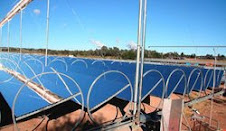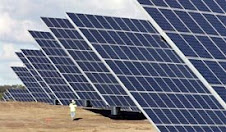Energy Efficiency Looks Sexier
article from:
http://www.redherring.com/Article.aspx?a=17917&hed=Energy+Efficiency+Looks+Sexier§or=Industries&subsector=VentureCapital
Cleantech Venture Network: Venture investments in the niche more than triple.
August 10, 2006
Venture capital investment in energy efficiency technologies more than tripled in the second quarter year-over-year, according to a report released Thursday by the Cleantech Venture Network.
Energy efficiency investments reached $60.9 million, compared with $15.2 million in the same period last year, according to the industry monitor based in Ann Arbor
, Michigan.
“I think it’s just the beginning; there are a lot more companies that will be coming on line looking for funding,” said Joel Makower, a principal of research firm Clean Edge.
In May, energy management startup GridPoint raised $16 million, Prenova raised $11 million, and Broadband Energy Network raised more than $2 million. Fat Spaniel raised $3.5 million in March, and Comverge raised $5.5 million in April (see GridPoint Gets $16M Recharge, Energy Management Bags Cash, Energy Startup Gets $3.5M, Energy Management Gets Cash).
‘Energy efficiency is a sleeping giant.’
-Robert Wilder,
WilderShares
- ADVERTISEMENT -
All this in spite of the fact that industry watchers say energy efficiency is not “sexy.”
“Energy efficiency is a sleeping giant,” said Robert Wilder, CEO of WilderShares, which manages two clean-energy indices. “It doesn’t have the sexy allure of solar power or huge wind. But we have Saudi Arabia-sized oil reserves under our feet in America through energy efficiency.”
Mr. Makower agreed, saying venture capital funding for energy management companies typically is seen as less glamorous than funding high-tech energy production companies.
But as cleantech investments grow, investments in energy efficiency and energy management technologies are becoming more significant.
“For a long time in the venture community, it was said that efficiency isn’t sexy,” Mr. Makower said. “But I think we’re staring to see there is a lot of business to be done in the efficiency area, which is what energy advocates have been saying for a long time.”
Heat Wave Sparks Attention
The news of increased funding comes in the wake of a record-breaking heat wave last month that sparked power outages from California to New York. During one record-setting week in July, thousands of California customers lost power for days as 860 transformers—worth about $1 million—malfunctioned or stopped working, reported the Los Angeles Times.
While analysts said one such event is not going to influence funding, the blackouts certainly gave energy efficiency and storage companies a quick jot of attention from VCs and policy makers.
“This past week, without demand response, New England and New York would have faced the potential for rolling blackouts,” said Tim Healy, chief executive of EnerNOC.
Ultimately, technology that reduces the demand for electricity on the grid is as relevant to the electricity grid’s health as energy-producing technologies such as solar and wind power—even though those more glamorous technologies get the most attention from investors.
With energy costs on the rise, energy management companies see a significant trickle-effect of VC interest in their technologies (see Negawatts for Postive Returns).
Some VCs Still Shy
Still, some VCs shy away from funding efficiency companies because, for most of the year, energy demand is only at 60 to 70 percent of its capacity, said Chris Hickman, an executive vice president of Cellnet, a company that builds fixed wireless networks for energy metering.
But times of high demand on the grid—like during the heat wave that scorched the country earlier this summer—reveal its weaknesses.
“What we have forgotten about as a country is grid efficiency,” Mr. Hickman said. “If you can not consume megawatts on the grid, that is dramatically more valuable than constructing green megawatts. We have to let technology catch up with policy to make sure we don’t stress the grid beyond its true capabilities.”
Policy largely influences the financial success of energy efficiency companies. It takes localized government initiatives providing financial benefits to convince utility companies, retailers and industrial owners to sign up for energy reduction programs, industry watchers said.
“Utilities are under a lot of pressure to improve operating efficiencies, and this requires investment in many of the techs,” said Roberto Torres, a strategic analyst for Frost & Sullivan. “Yet they're also under lots of pressure to reduce spending and improve financial performance so there are budget constraints. They’re in a tight spot.”
New Models
That’s why some companies are targeting consumers, not just utilities. Demand-response companies, for example, monitor electricity demand and cut nonessential electricity in customer houses, stores, and industrial buildings to prevent blackouts in times of strain.
ConsumerPowerline, Comverge, and Red Herring 100 N.A. finalist EnerNOC entice retailers and homeowners with money: utilities pay them for the power they save, and they turn over a portion of their profits to the consumers (see Checks for Demand Response; Negawatts for Postive Returns).
Another new approach is that of Ice Energy’s Ice Bear, a device that stores off-peak energy by making ice using a standard compressor and releasing the stored energy in the ice during the day to provide cooling.
balance of article at:
http://www.redherring.com/Article.aspx?a=17917&hed=Energy+Efficiency+Looks+Sexier§or=Industries&subsector=VentureCapital
Best Green Stocks Investing Blog
Subscribe to:
Post Comments (Atom)
Yuya Joe Blog
Lake Ontario Waterkeeper
The Daily Beast -Politics Blog
21stArch.com - 21st Century Architecture
Original Joe College Blog
WikiLeaks Foreign Policy Analysis
AGreenRealtor.com Real Estate Blog - Ecology Energy Efficiency
Best Green Stocks Investing Blog
PV Intell Photovoltaic Solar Stocks Investing
SEARCH Leading Alternative Energy and Ethical Investing websites

Custom Search
Daily Kos
Rare Earth Stocks Research
Patrick MacManus's Blog Peace and Collaborative Development
BeesTreesFrogsElephants.com - Nature and Ecology Blog
Research Green Energy stocks, Clean Energy investing information
Find wind power investing info online, clean energy mutual funds, geothermal stocks, solar energy investments.

Green Energy Investing Network:
Green Stocks Investing Clean Power Blog
SolarIntell.com Renewable Power Investing Website
Wind Intell.com Wind Energy Stocks Company Links
Geothermal Power Investing Public Companies
PV Intell.com Leading Photovoltaic Solar Energy Stocks

Custom Search
Green Energy Investing Network:
Green Stocks Investing Clean Power Blog
SolarIntell.com Renewable Power Investing Website
Wind Intell.com Wind Energy Stocks Company Links
Geothermal Power Investing Public Companies
PV Intell.com Leading Photovoltaic Solar Energy Stocks







No comments:
Post a Comment